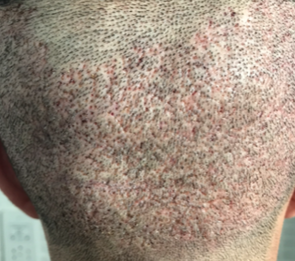Hi Dr. Rassman,
I find your blog to be incredibly informative and helpful to those with concerns after their hair transplants. I decided to undergo a transplant exactly 5 months ago as preventative maintenance. 1,700 grafts to fill-in the thinning top portion of my head. I still have hair on my head, but under direct light you could visibly see through to my scalp. I followed my doctor’s instructions and had no major issues after the surgery.
At 5 months, the incision scar is still pink and I have occasional pimples on the top of my head (with what seems to be a noticeable increase in grease on my head). Also, after the surgery I had shock fallout. But it seems that ever since my surgery for the last five months my shedding has been consistently increased. Not just from the top of my head, but all over (sides and back). I have yet to see any growth from the grafts. But I have noticed white streaks in my hair. I have pitch black hair, and there are now random strips of white developing throughout my hair (I had never had white hair before the surgery). Is it possible that the shock of surgery would cause some of my hairs to begin to turn white?
And I’m also concerned at this point that my grafts will not grow in and that I will continue to get thinner and thinner since my fallout has increased. Thank you for your input and advice.
In my practice, we never recommend a hair transplant surgery for “preventive maintenance”, mainly because most patients would not likely see much of a result as they continue to bald and run the risk of being worse off. There is also a good possibility that the surgically induced hair loss might make it look worse, something we call “shock loss”.
If you are really losing hair on the sides, maybe something else is going on like diffuse unpatterned alopecia (DUPA). Shock loss doesn’t usually cause hair to fall out from the back and sides of the head. White hair does appear with stress on some people, but I really do not understand the cause. It sounds like you need a good doctor to talk with and be examined by. Perhaps the surgeon that did your transplant would be a place to start.
In general it takes about 6 to 8 months before you can see results and I tell my patients that most people can see 80% of the impact from a hair transplant in 8 months. You should notice growth beginning about now and see improvement in the next 3 months. If you are young and had the transplant without taking the drug finasteride, and assuming that your preventive hair transplants were not really needed, then you will most likely not have as much hair as you did before the transplant (based upon what you are saying here). Hopefully though, over the next 3 months you’ll see some gains.

